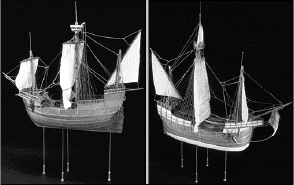 Christopher (Italian Cristoforo Colombo, Spanish Cristóbal Colón) was the son of the weaver Domenico Colombo and his wife Suzanna Fontanarossa. The family lived in the Italian port city of Genoa but was probably of Spanish-Jewish origin.
Christopher (Italian Cristoforo Colombo, Spanish Cristóbal Colón) was the son of the weaver Domenico Colombo and his wife Suzanna Fontanarossa. The family lived in the Italian port city of Genoa but was probably of Spanish-Jewish origin.Navigator and explorer, b. between 26 August and 31 October 1451 (Genoa, Italy), d. 21 May 1506 (Valladolid, Spain).
 Christopher (Italian Cristoforo Colombo, Spanish Cristóbal Colón) was the son of the weaver Domenico Colombo and his wife Suzanna Fontanarossa. The family lived in the Italian port city of Genoa but was probably of Spanish-Jewish origin.
Christopher (Italian Cristoforo Colombo, Spanish Cristóbal Colón) was the son of the weaver Domenico Colombo and his wife Suzanna Fontanarossa. The family lived in the Italian port city of Genoa but was probably of Spanish-Jewish origin.
Probably through his brother, who had worked in the cartographic workshop of the Portuguese court, Columbus had seen a chart that showed islands to the west of Europe. (Menzies, 2003) Convinced of the spherical nature of the earth, Columbus believed that profit could be made by sailing there and that there was a way to reach the East, ie. Asia, via those islands. In 1492 he found patrons to finance his voyage: King Ferdinand and Queen Isabella of Spain supported his plans.
On 3 August 1492 Columbus set sail with three ships. Santa María, the largest of his fleet, was 26 m long, the other two, Niña and Pinta, were Portuguese caravels of the type introduced under Henry the Navigator and even smaller than the Santa María. On 12 October he reached the Caribbean Islands in Central America.
Columbus undertook a second voyage in 1493 - 1496. During his third voyage in 1498 - 1500 he reached mainland South America. His poor administrative talent lost him the favour of the Spanish court, and he undertook his fourth and last voyage in 1502 - 1504 against express Royal orders. He became ill during the voyage and never recovered completely. On his death bed he declared that he wanted to be buried in the West Indies.
He was initially buried in Seville (Spain), but his body was exhumed in 1542 and brought to rest in the Cathedral of Santo Domingo in Hispaniola (today's Dominican Republic), which he had reached in 1492. Some 250 years later Spain ceded the island to France and took Columbus' remains to Havana, Cuba. When Spain lost that island the defeated navy took his remains back to Seville where, to honour his wish, a tomb was erected above the cathedral floor to avoid him being interred in Spanish soil.
The transfer to Spain remains controversial. A box with the inscription "Illustrious and enlightened male Christopher Columbus" was discovered in the Cathedral of Santo Domingo in 1877, and the Dominican Republic insists that the wrong bones were returned to Spain.
Columbus. Encyclopaedia Britannica 15th ed. (1995)
Menzies, G. (2003) 1421, the Year China Discovered America. Harper Collins, New York.

Models of the Santa María (left) and the Pinta (right).
The Mariner's Museum, Newport News, Virginia, USA